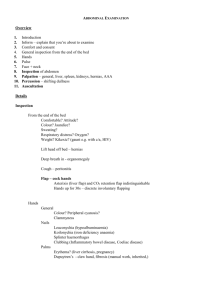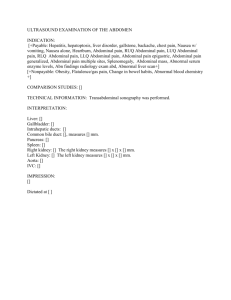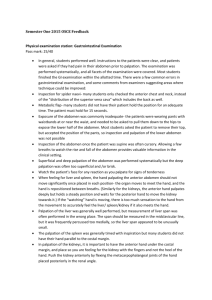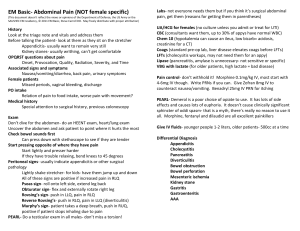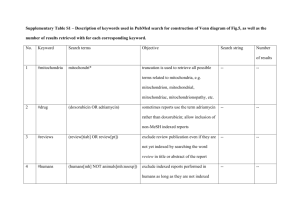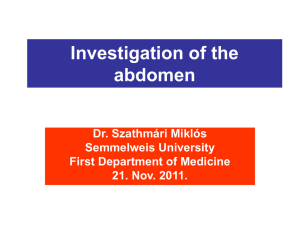GEORGIA BAPTIST COLLEGE OF NURSING
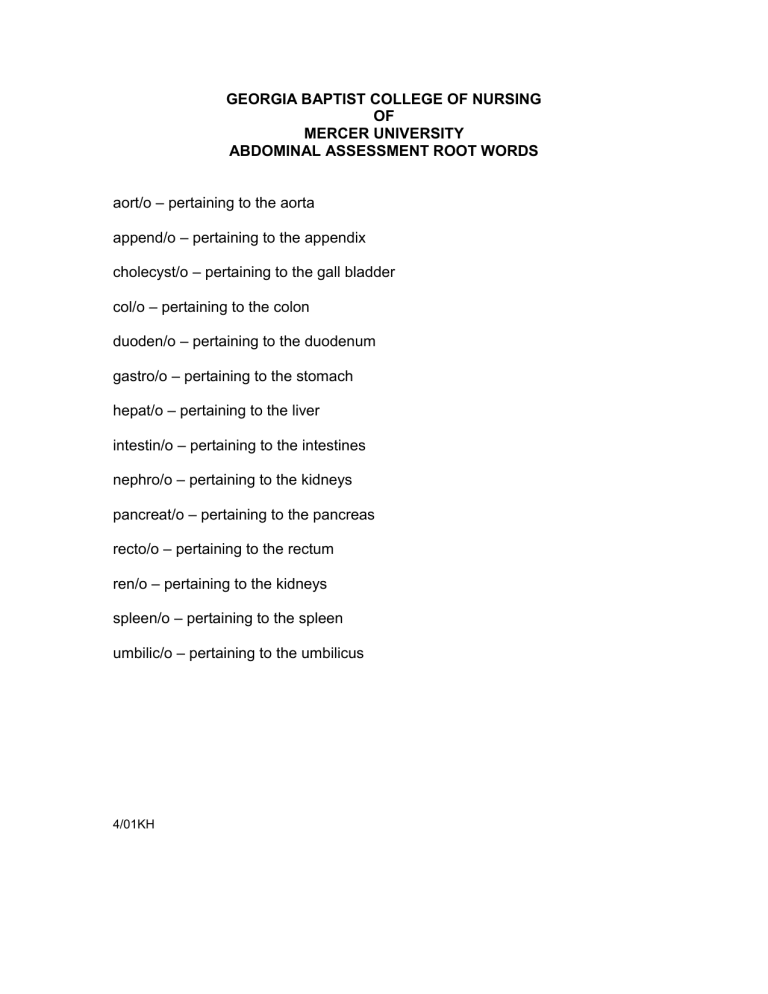
GEORGIA BAPTIST COLLEGE OF NURSING
OF
MERCER UNIVERSITY
ABDOMINAL ASSESSMENT ROOT WORDS aort/o
– pertaining to the aorta append/o – pertaining to the appendix cholecyst/o
– pertaining to the gall bladder col/o – pertaining to the colon duoden/o
– pertaining to the duodenum gastro/o – pertaining to the stomach hepat/o – pertaining to the liver intestin/o
– pertaining to the intestines nephro/o – pertaining to the kidneys pancreat/o
– pertaining to the pancreas recto/o – pertaining to the rectum ren/o – pertaining to the kidneys spleen/o
– pertaining to the spleen umbilic/o – pertaining to the umbilicus
4/01KH
ABDOMINAL ASSESSMENT
VOCABULARY
1. Abdomen – The large oval cavity extending from the diaphragm down to the brim of the pelvis. It is bordered in back by the vertebral column and paravertebral muscles, and at the sides and front by the rib cage and abdominal muscles. The abdominal wall is divided into four quadrants by a vertical and a horizontal line bisecting the umbilicus. The quadrants are called the right upper quadrant (RUQ), left upper quadrant (LUQ), right lower quadrant (RLQ), and left lower quadrant (LLQ).
2. Age related changes – Age related changes of the Gastrointestinal system include the following:
Adipose tissue is redistributed.
Abdominal musculature relaxes.
Salivation decreases.
Esophageal emptying is delayed.
Gastric acid secretion decreases.
Incidence of gallstones increases.
Liver size decreases (which may impair drug metabolism).
Peristalsis decreases.
3. Anorexia
– A loss of appetite for food. Anorexia may occur with gastrointestinal disorders or may be related to medication side effects, pregnancy, or psychological disorders.
4. Aorta – The large vessel, which delivers, oxygenated blood to the body. It lies left of midline in the upper abdomen. Below the umbilicus, the aorta bifurcates into the right and left iliac arteries, which become the femoral arteries.
5. Ascites
– Free fluid in the peritoneal cavity which occurs with congestive heart failure, portal hypertension, cirrhosis, hepatitis, pancreatitis, and cancer. The client will present with a distended abdomen, bulging flanks, and an umbilicus that is protruding and displaced downward.
6. Ballottement – Palpation technique used to assess a floating object.
Fluidfilled tissue is pushed toward the examiner’s hand so that the object will float against the examiner’s fingers.
7. Borborygmi – Hyperactive bowel sounds caused by hyperperistalsis;
“stomach growling”.
8. Bowel sounds
– Activity/sounds auscultated in the abdomen, which originate from the movement of air and fluid through the small intestine.
Bowel sounds are termed normal, hypoactive, and hyperactive. Bowel sounds are high-pitched, gurgling, cascading sounds which occur irregularly from five to 30 times per minute.
9. Hypoactive bowel sounds
– Diminished or absent bowel sounds related to decreased motility. Hypoactive sounds may be due to peritonitis, paralytic ileus, bowel obstruction, post-abdominal surgery, etc.
10. Hyperactive bowel sounds
– Increased bowel sounds related to increased motility. Hyperactive sounds may be due to gastroenteritis, diarrhea, subsiding paralytic ileus, etc.
11. Bruit
– Vascular sound, which indicates turbulent, blood flow. Bruits are found in constricted, abnormally dilated, or tortuous vessels. Use the bell of the stethoscope to assess bruits. Bruits may occur with an aortic aneurysm, renal artery stenosis, or partial occlusion of the femoral arteries.
12. Chloecystectomy
– Removal of the gallbladder.
13. Chloecystitis – Inflammation of the gallbladder.
14. Chloelithiasis
– Condition of gallstones.
15. Cirrhosis – Disease characterized by destruction of liver parenchyme.
The affected liver is characterized by fibrous tissue and yellow-tan nodules.
16. Contour
– The shape of the abdomen. Determine the profile from the rib margin to the pubic bone. Contour may be described as flat, scaphoid, rounded, or protuberant.
17. Costovertebral Angle tenderness
– Technique used to assess kidney inflammation. To assess the kidney, place one hand over the 12 th rib at the costovertebral angle on the back. Thump that hand with the ulnar edge of your other fist. This indirect fist percussion causes the tissues to vibrate instead of producing a sound.
18. Diastasis recti abdominis
– Separation of the rectus muscles of the abdominal wall. May be caused by pregnancy or obesity.
19. Dysphagia – Difficulty swallowing which occurs with disorders of the throat or esophagus.
20. Epigastric
– The abdominal area located between the costal margins.
21. Eructation – Belching.
22. Flatulence – Presence of excessive amount of gas in the gastrointestinal tract.
23. Fluid wave
– A test utilized to differentiate ascites from gaseous distension. To assess flui d wave, stand at the client’s right side. Place the ulnar edge of client’s hand firmly on the midline of the abdomen.
Place your left hand on the client’s right flank. With your right hand, reach across the abdomen and firmly strike the left flank. If ascites is present, striking the flank will generate a fluid wave through the abdomen. You will feel a distinct tap on your left hand. With gaseous distension, you will feel no change.
24. Gastrectomy – Removal of all or part of the stomach.
25. Hematemesis – Vomiting blood which occurs with pyloric or duodenal ulcers and esophageal varices.
26. Hepatitis – Inflammation of the liver.
27. Hepatomegaly
– Enlargement of the liver which may occur with fatty infiltration, portal obstruction, cirrhosis, obstruction of the inferior vena cava, or lymphocytic leukemia.
28. Hernia
– Protrusion of abdominal viscera through abnormal opening/weakness in the muscle tone.
29. Hooking technique
– A technique of palpating the liver. Stand at the client’s shoulder, swivel your body to the right so that you face the client’s feet. Hook your fingers over the costal margin from above. Ask the client to take a deep breath. Feel for the liver edge to bump your fingertips.
30. Hyperresonance – The sound percussed when gaseous distension of the abdomen is present.
31. Hypogastric – The area above the pubic bone.
32. Inspiratory Arrest
(Murphy’s Sign) – Assessment technique to determine cholecystitis. Palpating the liver normally does not cause pain; however, pain may occur with cholecystitis. To assess, hold your fingers under the liver border (hooking technique). As the descending liver pushes the inflamed gallbladder onto the examining hand, the client feels sharp pain and abruptly stops inspiration midway.
33. Jaundice
– Yellowish discoloration of the skin. Jaundice is indicative of elevated levels of serum bilirubin. Jaundice is often seen in clients with hepatic disease.
34. Kidney
– Bean-shaped organs which are retroperitoneal, or posterior, to the abdominal contents. The kidneys are protected by the posterior ribs and musculature.
The 12 th rib forms an angle with the vertebral column, known as the costovertebral angle. The left kidney lies here at the 11 th and 12 th ribs.
The right kidney may be palpable as it rests 1 to 2 cm lower than the left kidney because of the placement of the liver.
Assessment: Assess the right kidney by placing your hands in a “duckbill” position, at the client’s right flank. Press your hands together firmly and ask the client to take a deep breath. In most clients, you will feel no change. (You may feel the lower pole of the right kidney, as it rests lower than the left kidney).
Assess the left kidney by reaching your left hand across the client’s abdomen and behind the left flank for support. Push your right hand deep into the abdomen and ask the client to take a deep breath. You should feel no change.
35. Linea alba
– The tendinous seam, located midline of the abdomen, which joins the four layers of muscle that form the ventral abdominal wall.
36. Liver
– The large organ located in the RUQ of the abdomen. The liver fills most of the RUQ and extends over to the left midclavicular line. The normal liver span in the adult ranges from 6 to 12 cm.
37. Liver palpation
– Place your left hand under the client’s back parallel to the
11 th and 12 th ribs and lift up to support the abdominal contents. Place your right hand on the RUQ, with fingers parallel to the midline. Push down deeply. Ask the client to take a deep breath. You may also use the hooking technique.
38. Melena
– Occult blood in the stools. Stools will appear tarry.
39. Midline – The middle of the abdominal cavity; the vertical line dividing the right and left abdominal quadrants. Structures located midline include the aorta, uterus (if enlarged), and bladder (if distended).
40. Nephrectomy- Removal of a kidney.
41. Nephromegaly – Enlargement of the kidney. Nephromegaly may be associated with cyst, hydronephrosis, and neoplasm.
42. Periotoneal friction rub- A rough, grating sound (like two peices of leather rubbed together) indicative of peritoneal inflammation.
43. Pyrosis – “Heartburn”; a burning sensation in the esophagus and stomach related to gastric acid reflux.
44. Rebound tenderness – Technique used to assess peritoneal inflammation.
Use this technique when your client reports abdominal pain. Choose a site away from the painful area. Hold your hand 90 degrees or perpendicular to the abdomen. Push down deeply and slowly, then lift up quickly. This maneuver makes structures that are indented by deep palpation rebound suddenly. Perform this technique last.
45. Rigidity – Constant boardlike hardness of the muscles.
46. Spider nevi
– Cutaneous angiomas which may occur with hepatic disease or portal hypertension.
47. Splenectomy
– Surgical removal of the spleen.
48. Splenomegaly – Enlargement of the spleen. Often, splenomegaly occurs with acute infections, such ads mononucleosis.
49. Spleen – The organ located on the posterolateral wall of the abdominal cavity, under the diaphragm. It is not palpable normally. If it becomes enlarged, its lower pole moves downward and toward the midline.
To palpate the spleen, place your left hand over the client’s abdomen and behind the left side at the 11 th and 12 th ribs. Lift up for support. Place your right hand obliquely on the LUQ, with fingers pointing toward the left axilla and inferior to the rib margin. Push your right hand down deeply and ask the client to take a deep breath.
50. Striae (ilnea albicantes) – Silvery-white, linear, jagged marks about 1 to 6 cm in length.
51. Suprapubic – The area above the pubic bone.
52. Tympany- The predominate sound percussed over the abdomen.
Tympany occurs because air in the intestines rises to the surface when the client is in a supine position.
53. Umbilical – Pertaining to the area around the umbilicus.
54. Umbilical hernia – A protrusion of part of the intestine at the umbilicus.
55. Venous hum- A normal hum originating from the inferior vena cava and its large tributaries. Audible with a stethoscope placed in epigastric region.
Abnormal if present in periumbilical region or over the liver.
56. Viscera – Contents of the abdominal cavity.
1/97 FFJ;Revised 5/01,10/01 KH
